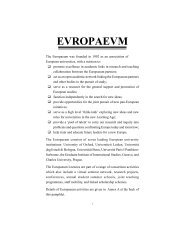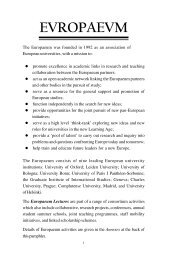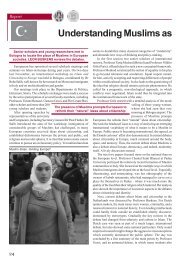Authors Iain Begg | Gabriel Glöckler | Anke Hassel ... - The Europaeum
Authors Iain Begg | Gabriel Glöckler | Anke Hassel ... - The Europaeum
Authors Iain Begg | Gabriel Glöckler | Anke Hassel ... - The Europaeum
Create successful ePaper yourself
Turn your PDF publications into a flip-book with our unique Google optimized e-Paper software.
However, the countries’ planning documents fail to specify the budget and<br />
terms for the financing of initiatives aimed at supporting the protection,<br />
social inclusion and representation of minorities in public life.<br />
Similarly to the legal framework, financial instruments have also seemed<br />
inconsistent and their effectiveness has been difficult to assess. Even if<br />
pre-accession instruments have underlined the importance of government<br />
intervention in addressing the social exclusion of minorities, the lack of<br />
evaluation and the ambiguity of monitoring reports on minority funding<br />
indicate the lack of a real engagement by the EU. 26 Arguably the most<br />
significant shortcoming of these EU initiatives has been the absence of a<br />
mechanism ensuring the participation of minority groups themselves in<br />
programmes aimed at improving their situation.<br />
Overcoming the economic and<br />
social exclusion of minorities<br />
This paper has presented evidence suggesting that the EU has had a<br />
different approach to regional cohesion when compared to that of social<br />
cohesion. Whereas the former issue has been addressed with a coordinated<br />
policy and great financial effort, the latter seems to lack both a policy<br />
agenda and harmonised financial instruments. Without undermining the<br />
importance of reducing regional disparities, the EU cannot leave aside<br />
social inequalities and in particular the problems experienced by<br />
vulnerable minority groups in old and new member states.<br />
In order to meet the objective of “economic and social cohesion” among<br />
its 27 member states, the EU will have to start taking a more assertive<br />
position on minority rights. Minority protection in the EU needs to be<br />
structured with a stronger policy agenda, demonstrated through (1) legal<br />
provisions for collective minority rights and (2) stronger financial<br />
instruments targeting minority groups.<br />
So far, the EU’s approach to internal diversity has revolved around a<br />
comprehensive framework for anti-discrimination, whose provisions<br />
must be transposed into domestic law by member states. Although the<br />
Race Directive is a promising instrument for the protection of cultural<br />
diversity, anti-discrimination provisions – essentially individual rights –<br />
cannot alone ensure the protection of minorities. Rather, nondiscrimination<br />
and minority rights should be seen as complementary,<br />
respectively ensuring equality and preserving diversity. Social cohesion<br />
cannot be achieved without legal provisions tailored specifically to<br />
vulnerable minority groups and ensuring their participation in the<br />
148<br />
After the crisis: A new socio-economic settlement for the EU

















